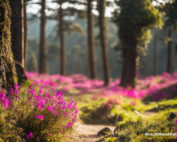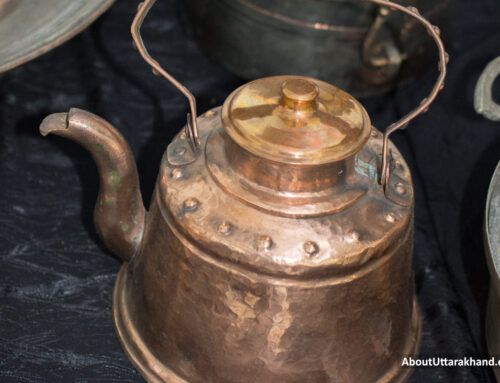Traditional Ornaments Of Uttarakhand
Situated in the foothills of the Himalayas, the state of Uttarakhand is home to a vibrant cultural history that is on full display in the beautiful scenery and traditional attire of its inhabitants. The traditional ornaments of Uttarakhand showcase the meticulous artistry, refined taste, and enduring cultural practices of the region. All around this beautiful state, from shimmering hills to crowded marketplaces, you may see these decorations that are important to the traditions and culture of the many people that live here.
The ornaments do more than adorn; they capture the cultural practices, artistic abilities, and religious beliefs of the people of Uttarakhand. Wearing these garments, whether for religious or secular celebrations or just because, is like slipping into a colourful tapestry of Uttarakhand's cultural heritage. Unravelling the ties that bind the distinctive and fascinating jewellery traditions of Uttarakhand, this research delves into the symbolic importance, crafting methods, and deep cultural resonance of traditional jewels.
Table Of Contents
- Traditional Ornaments Of Uttarakhand
- Physical Construction Of Ornaments Of Uttarakhand
- Types Of Traditional Ornaments Of Uttarakhand
- Bichhuwa
- Bulaq
- Dhagulu
- Galobandh
- Hansuli
- Kamarbandh
- Kundal
- Kundan
- Matar Mala
- Nathuli
- Pahunchi
- Pauje
- Sitarami
- Occasion When Ornaments Of Uttarakhand Is Worn
- Availability Of Ornaments Of Uttarakhand
- To Conclude
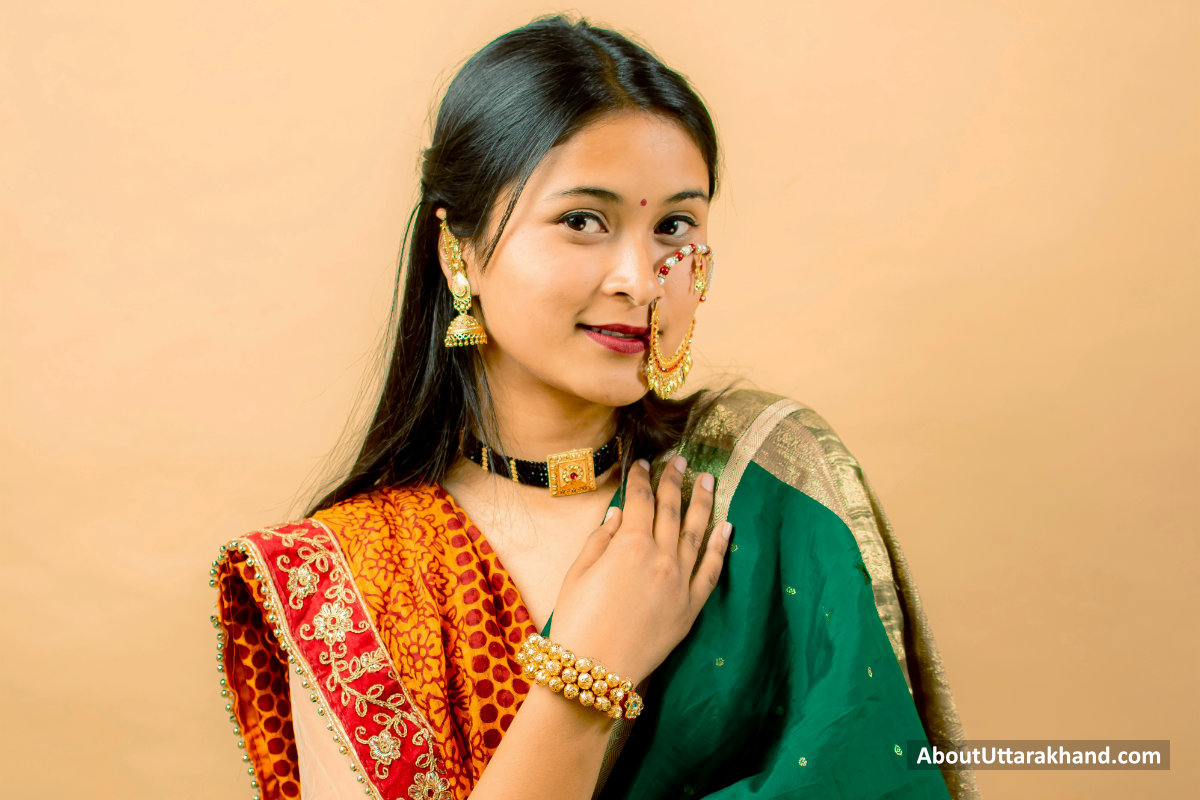
Photo By Vishwanath Negi on unsplash
Physical Construction Of Ornaments Of Uttarakhand
The meticulous craftsmanship and deep cultural roots of the Uttarakhandi people are on display in the actual creation of traditional ornaments. Carefully made with an eye for detail, these embellishments display a one-of-a-kind combination of age-old methods and creative imagination. The ornaments are crafted from metals including copper, silver, and gold, and feature elaborate designs and motifs that showcase the cultural aesthetics of the several communities in the state.
Uttarakhandi jewellery is known for their intricate craftsmanship, which is characterised by methods like embossing, granulation, and filigree work. In example, the filigree technique gives jewellery a delicate, otherworldly aspect by painstakingly sculpting thin threads of metal into complex patterns. A rough sheen is added to the jewellery by granulation, which is the painstaking arrangement of little metal beads, increasing its aesthetic value.
Symbolic symbols drawn from religion, mythology, and nature adorn these classic jewellery. Making jewellery and other artefacts that embody Uttarakhandi culture requires a symphony of abilities that has been handed down through many years. The artistic skill of the region is on full display in the physical creation of these ornaments, which serve as a link between the people of the region and the tradition that is ingrained in each meticulously crafted piece.
Types Of Traditional Ornaments Of Uttarakhand
Traditional jewellery is a great example of Uttarakhand's rich cultural history. As a unique piece of jewellery, the 'Bichhuwa' toe ring shows marital status and cultural past. The traditional nose ring called 'Bulaq,' which married women wear, is a beautiful sign of wealth and happiness in marriage. Tradition necklaces like the 'Galobandh,' a beautiful piece of jewellery that has been passed down through many generations, and the 'Hansuli,' a necklace with a unique circular shape, show off Uttarakhand's artistic ability and cultural wealth.
Wearing the 'Kamarbandh' around the waist on traditional events makes it even more attractive. India's artists make beautiful 'Kundal' earrings and 'Kundan' jewellery that shows how good they are at their craft. Wearing elaborate nose rings called 'Nathuli' and bead necklaces called 'Matar Mala' are cultural symbols that people are happy to show off at festivals. For example, 'Pahunchi' and 'Pauje' are rhythmic anklets that are used in lively regional dances. Finally, the 'Sitarami' bridges Uttarakhand's many cultural differences while also representing a spiritual link through traditional jewellery.
For those who are interested, more information about these beautiful pieces of Uttarakhand State jewellery is available. Additional information is given below.
Bichhuwa
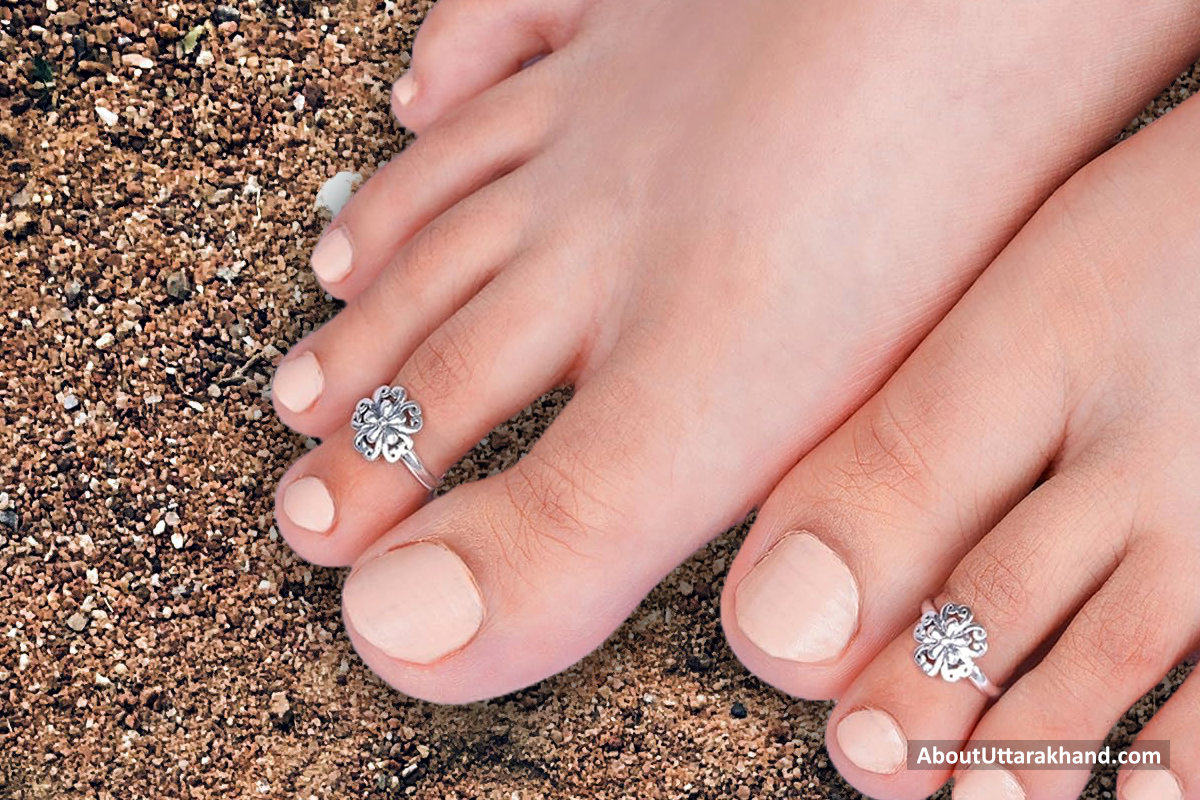
Bichhuwa, Traditional Ornament Of Uttarakhand | Photo By AboutUttarakhand.com
Among the many cultural artefacts from Uttarakhand, the Bichhuwa—the 'toe ring'—is particularly noteworthy and treasured. The artistic delicacy and lasting cultural importance of this silver traditional decoration elevate it beyond the status of a mere ornament. Intricate patterns adorn the top surface of the Bichhuwa, which showcases the exquisite craftsmanship of local artisans, a talent that has been passed down through centuries.
For women in Uttarakhand, the Bichhuwa is more than just a piece of clothing; it's a symbol of their heritage and culture. The toe ring represents the region's long history of artistic excellence; it is both a relic of the past and an homage to the region's timeless cultural values. Beyond its decorative use, the Bichhuwa signifies a woman's marital status and her dedication to her husband.
Due in large part to the silver content, the metal utilised greatly enhances its attractiveness and longevity. Elevating the Bichhuwa's cultural and artistic importance, silver is prized for its purity. By wearing this pendant with pride, ladies are perpetuating a custom that is fundamental to the cultural identity of Uttarakhand.
In conclusion, the Bichhuwa becomes more than just jewellery; it becomes a treasured representation of heritage, artistry, and culture. This cultural emblem has stood the test of time in Uttarakhand, proving that certain things never really die.
Bulaq
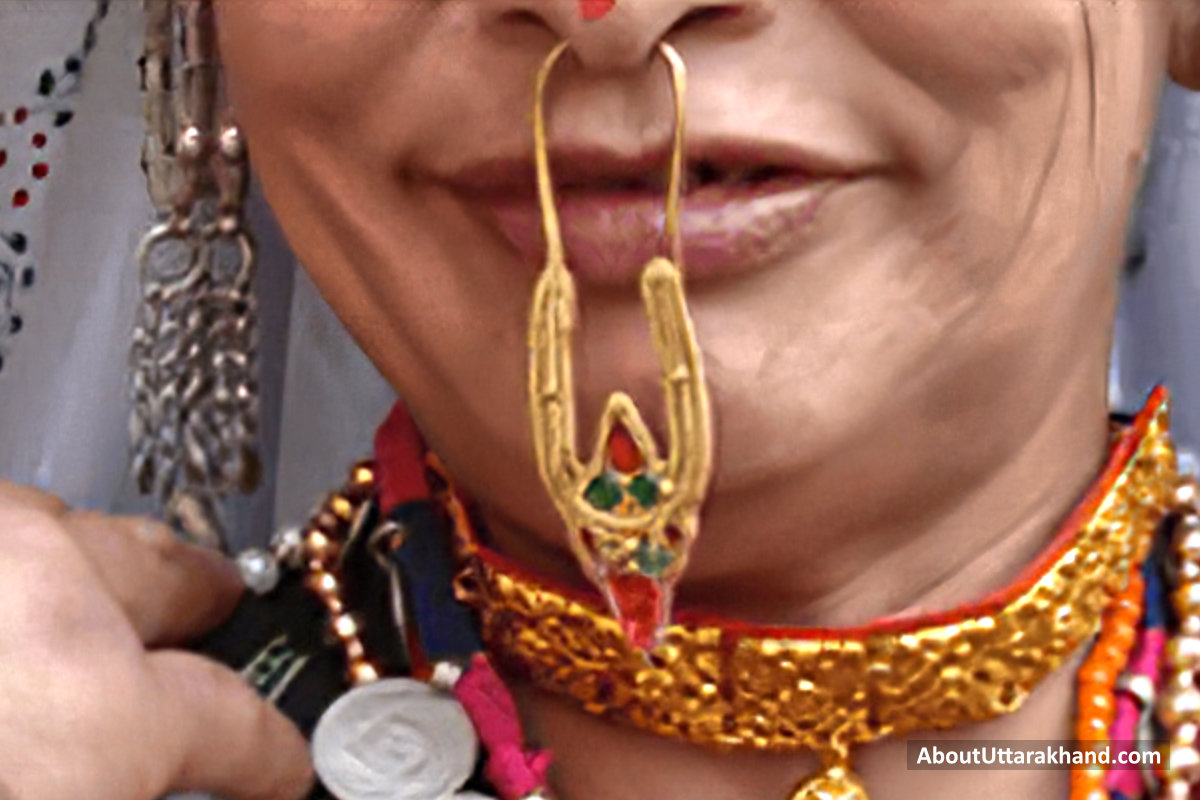
Bulaq , Traditional Ornament Of Uttarakhand | Photo By AboutUttarakhand.com
The cultural history of the Garhwal, Kumaon, and Jaunsar belt regions is enriched by the distinctive nose jewellery known as Bulaq, which is meticulously crafted by master goldsmiths. Wearing this magnificent piece at the nasal septum is a testament to the skill of the local craftspeople who carved its elaborate theme designs. A piece of jewellery that was previously a staple in women's jewellery boxes is now much more exquisite thanks to the addition of gold.
Women used to wear the Bulaq as a badge of honour and a representation of their culture's beauty and heritage. It was a way for women from these areas to express themselves artistically. But as things have changed, Bulaq's appeal has diminished, and it is now seen as a passing fad. Its dwindling popularity is a reflection of how people's tastes in clothing and social norms are changing.
As a cultural relic that captures the ebb and flow of ancient jewellery styles, Bulaq is important for more than just its elaborate design. The once-popular Bulaq is now seen as a throwback to a more innocent time due to the prevalence of modern fashions.
Last but not least, Bulaq is an example of how cultural expressions and fashion can change over time due to its complex design and historical importance. Although its popularity has faded, it is still highly prized because of the cultural wealth it captured in the areas where it was popular.
Dhagulu
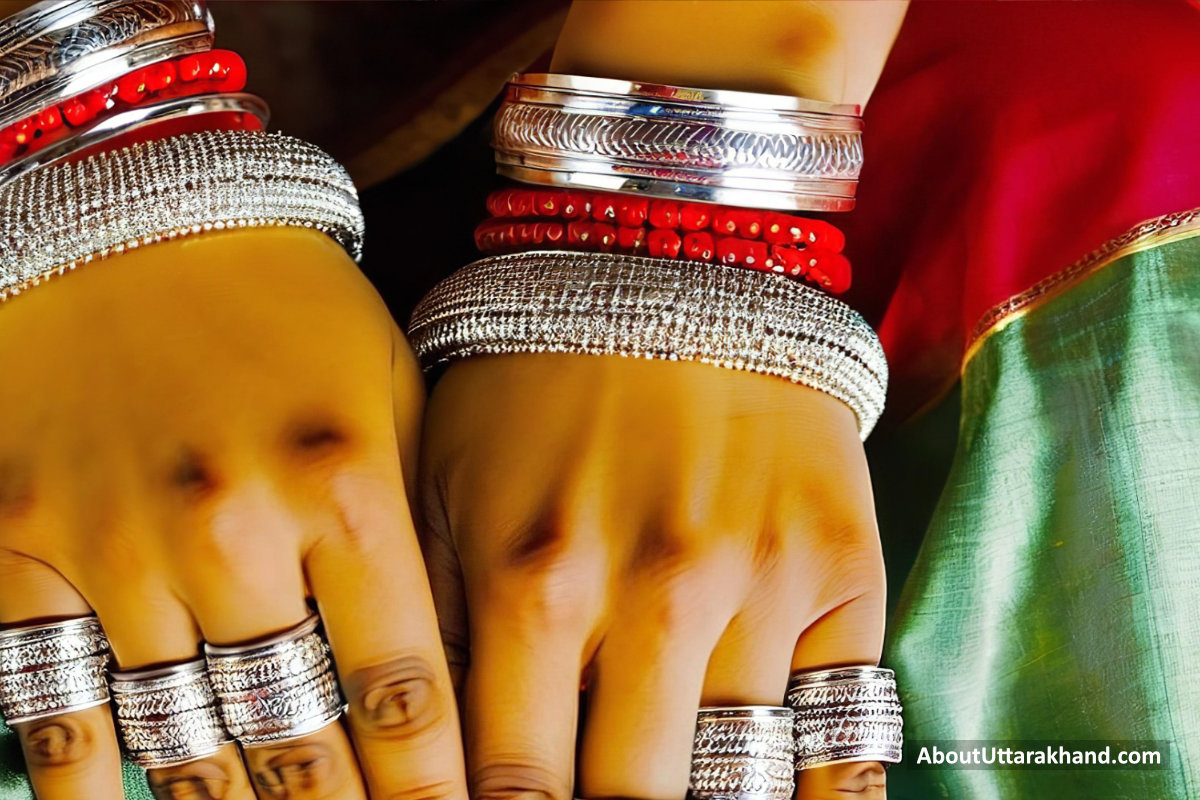
Dhagulu, Traditional Ornament Of Uttarakhand | Photo By AboutUttarakhand.com
The traditional silver dhaglu bangle, which is round in shape, is an important element of the jewellery legacy of Uttarakhand, especially in areas that are bordered by Nepal, like Kumaon. The use of silver in its production not only gives it a refined air, but also represents the everlasting importance of quality workmanship and unadulterated materials.
Dhaglu is more than just an accessory in Uttarakhand, particularly in the Kumaon region; it is a cultural symbol that links the wearer to the long history of the region. The bangle is a favourite among local ladies due to its circular form, which represents everlasting love and devotion. Dhaglu is still a beloved item, particularly among elderly women who take great pride in wearing this unique piece of jewellery, even though it is not as popular as it once was.
The utilisation of Dhaglu further mirrors the cultural and historical connections between Nepal and Uttarakhand. Because it is something both areas participate in, it helps to cement their shared culture. The cultural importance and timeless allure of Dhaglu are evident even in modern times when older women painstakingly wear it.
Finally, Dhaglu is a living testimony to Uttarakhand's cultural legacy because to its silver artistry and iconic circular pattern. The fact that elderly ladies still wear it shows how important this classic item is in the world of fashion and jewellery, even though styles come and go.
Galobandh
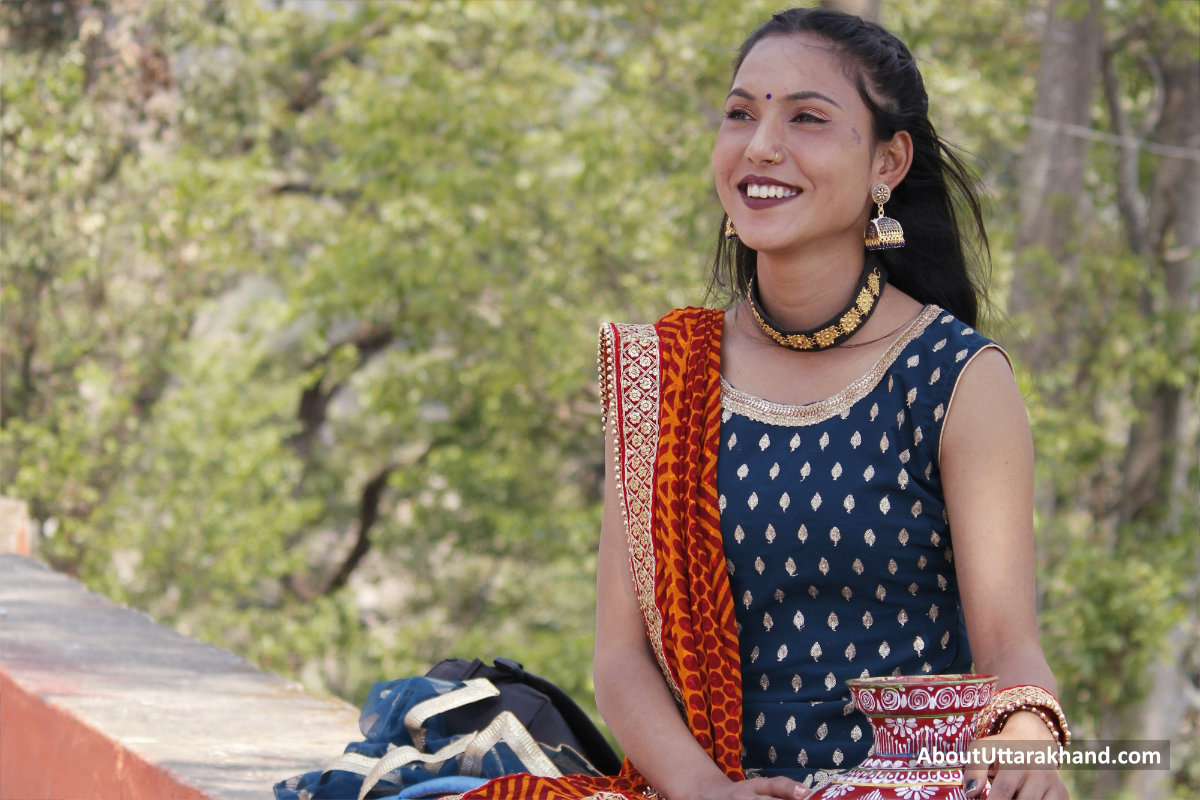
baby-boy-names-and-meaning | Photo By Dheeraj Mehra on unsplash
One of the most prominent pieces of jewellery in the Kumaoni, Garhwali, Bhotiya, and Jaunsari populations of Uttarakhand is the Galobandh, which goes by several names. Married ladies only wear this distinctive neck adornment, which is a sign of cultural identity and marital status. Sewn onto a crimson belt, the Galobandh showcases golden jewellery pieces arranged in a complex square pattern, giving it a sophisticated and unique appearance that is reflective of the artistic legacy of the area.
When it comes to Uttarakhandi marriage and femininity rites, the Galobandh is more than just a pretty piece of clothing. The rural ladies who still wear and respect this traditional decoration hold it in high regard because of the cultural richness it imparts through the use of certain colours and materials.
As contemporary jewellery styles take over, the Galobandh is losing ground in popularity, which is a shame because of its cultural importance and graceful design. Especially among city people, this traditional neckpiece is losing popularity due to urbanisation and shifting fashion tastes. But the fact that it still has fans in more remote places shows how cultural traditions can endure strong even when fashions change.
Finally, the culturally significant and artistically distinctive Galobandh represents the illustrious history of Uttarakhand. Although it is being overshadowed by modern fashions, the Galobandh continues to be worn by rural women as a symbol of the rich cultural diversity of the area and a call to honour and conserve such traditional jewellery.
Hansuli

Hansuli, Traditional Ornament Of Uttarakhand | Photo By AboutUttarakhand.com
Hansuli, a sacred neck adornment worn by women of the Garhwal, Kumaon, Jaunsar, and Bhotiya communities in Uttarakhand, is also called 'Khagwali' in Garhwali. During festivals, weddings, social events, and important family functions, Pahari ladies don this gorgeous neckpiece, which lends a touch of ethnic refinement to their clothes. This traditional jewellery is accessible to a wide spectrum of society because the wealthier use gold and the less fortunate use silver.
The Hansuli is more than just a pretty flower; it is a cultural icon that represents heritage and individuality. The allure of Hansuli, on the other hand, is dwindling in the modern day because to the preference for more modern and valuable jewellery. Traditional ornaments like the Hansuli are in danger of extinction due to this change in taste.
Because the Hansuli is more than just jewelry—it is a heritage that has adorned Pahari women for generations—the possible loss of its cultural importance is worrisome. The allure of this timeless accessory is dwindling, and with it comes the danger that conventional jewellery may become irrelevant as a result of changing tastes.
Finally, the Hansuli is a historic artefact from Pahari culture, but its declining popularity due to industrialization makes one wonder what the future holds for Uttarakhand's traditional jewellery. If the region's women are to carry on the Hansuli tradition and its rich history in their hearts and clothing, it is essential that these cultural icons be celebrated and preserved.
Kamarbandh
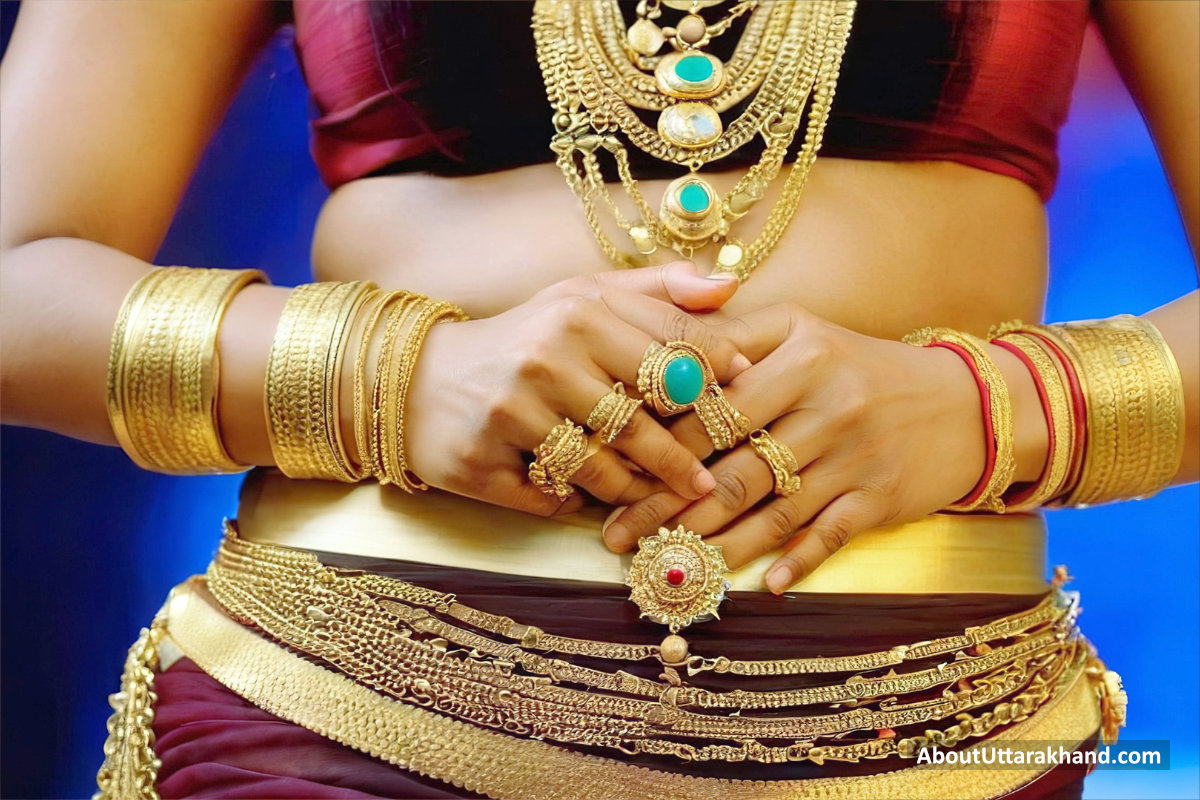
Kamarbandh, Traditional Ornament Of Uttarakhand | Photo By AboutUttarakhand.com
Traditional waist ornaments worn by women from different communities in Uttarakhand are called Kamarbandh, Tagdi, or Tigdi. One version of this one-of-a-kind jewellery item is made of linen, while the other is elaborately plated in silver. Besides being an ornament, its location around the waistline is a cultural expression that brings out the delicate femininity of the traditional women's clothing in the area.
The Kamarbandh is more than just an accessory; it represents elegance and heritage. When layered over their traditional garments, this belt enhances the beauty of Garhwali and Kumaoni ladies. The region's skill and love of precious metals are on full display in the silver Kamarbandh.
Many ladies in the Kumaon and Garhwal regions still love and show off this one-of-a-kind jewellery, even if it's not popular anymore. As a decoration that has stood the test of time, the Kamarbandh serves to both improve one's physical attractiveness and represent the rich cultural legacy of Uttarakhand.
To sum up, the Kamarbandh is a cultural symbol that connects the old with the new. The inclusion of these decorations in the clothing of women from the Garhwali and Kumaoni communities is a testament to their dedication to embracing and passing on their traditional ornaments, which will ensure that these one-of-a-kind pieces remain popular even as styles change.
Kundal
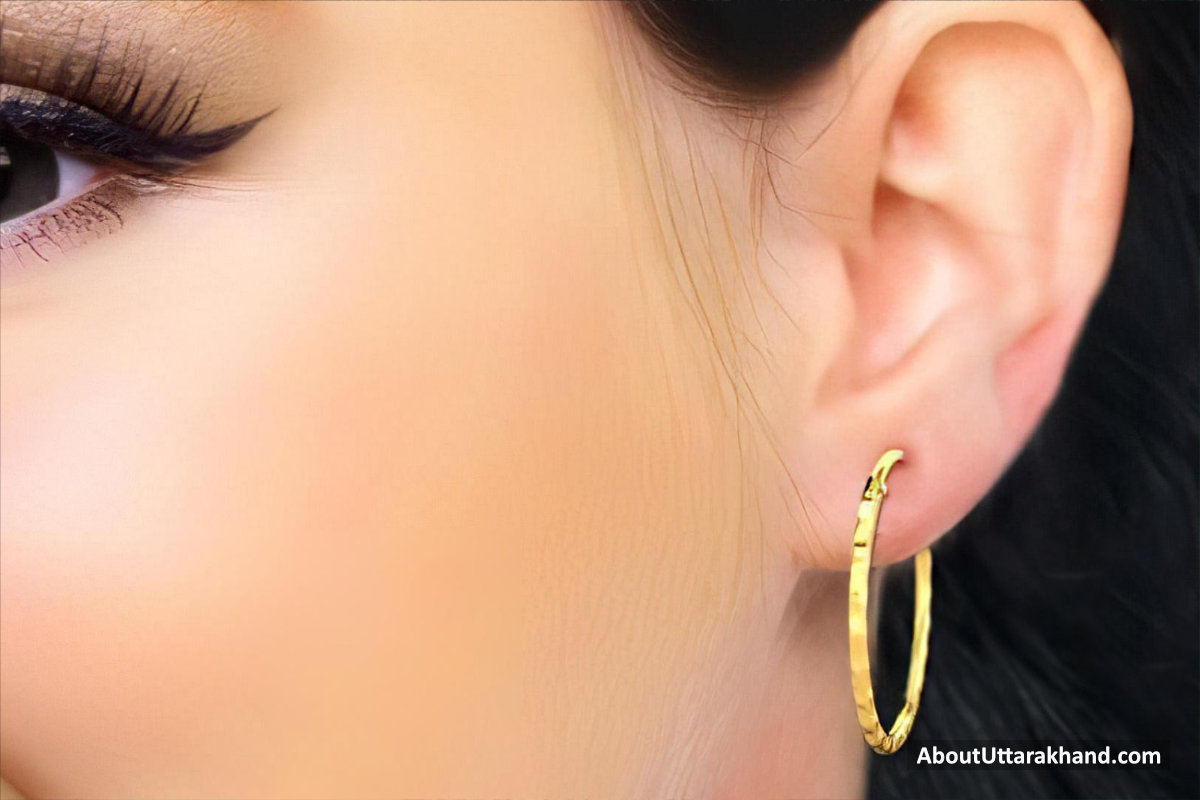
Kundal, Traditional Ornament Of Uttarakhand | Photo By AboutUttarakhand.com
Traditional earrings worn by Pahari women, kundals are called by a variety of names across various parts of Uttarakhand, including 'Munad,' 'Murkhli,' 'Munda,' 'Balli,' and 'Tugyal.' Gold or silver Kundals can range in size, shape, and design according to personal taste and social rank. While these earrings' elaborate workmanship was formerly adorned with conventional patterns, more recent times have seen a shift towards more modern and prettier designs.
Kundals are more than just an accessory; they are cultural artefacts that represent the uniqueness and history of traditional Pahari women. Individual preference and financial constraints are common factors in the selection of gold or silver Kundals. Transitioning from more conventional to more modern styles reflects the ever-changing character of cultural expressions.
Also, many Pahari women wear huge, round gold earrings called 'Balis.' These enormous decorations serve as symbols of ritual and heritage while simultaneously exuding an air of lavishness. Contemporary trends towards more contemporary designs provide a threat to the maintenance of traditional handiwork, even if Kundals and Balis remain essential components of Pahari women's jewellery.
Lastly, Kundals and Balis are unique aspects of Pahari culture that represent how tradition and modern style come together. These traditional decorations are a vital element of Uttarakhand's cultural identity, and it is important to recognise and protect their rich past as newer versions become popular.
Kundan
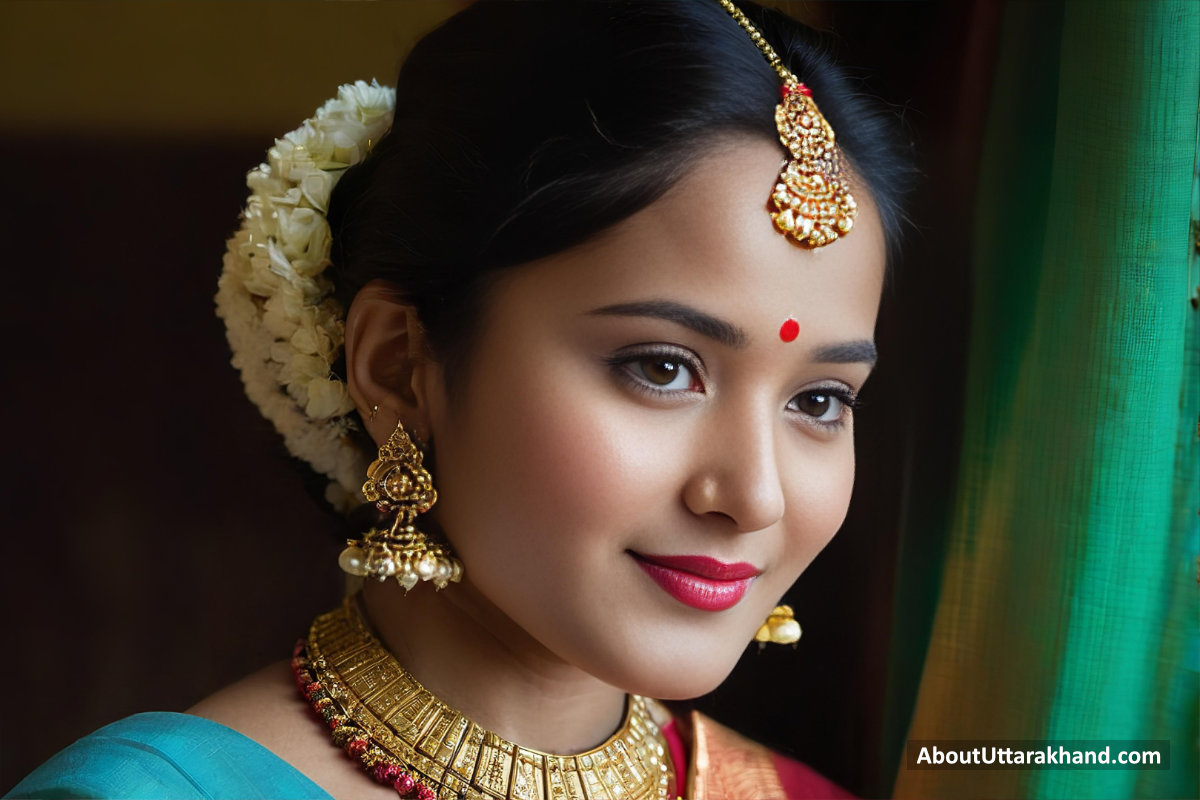
Kundan, Traditional Ornament Of Uttarakhand | Photo By AboutUttarakhand.com
One of the most distinctive traditional Uttarakhandi headpieces, worn by married ladies, is the Kundan Maang Tikka with chain. This stunning piece of jewellery is perfect for everyday wear as well as special events and celebrations. Made from either silver or gold, the metal typically indicates the wearer's socioeconomic position, illustrating the variety of cultural customs in the area.
The Kundan Maang Tikka is more beautiful than it already is thanks to its elaborate design and the diamonds or stones that embellish it. In addition to their aesthetic value, precious stones have deep metaphorical meaning, standing for abundance and good fortune. As a cultural symbol of marriage and an adornment for the beauty of married women in Uttarakhand, the Maang Tikka with chain serves as more than just an accessory.
This ornament's versatility and the way it blends tradition into the daily lives of the women in the region are both emphasised by its wearability. Nevertheless, the monetary concerns that impact the selection of conventional jewellery are mirrored in the decision between silver and gold.
Finally, the Kundan Maang Tikka with chain is a perfect example of how Uttarakhand's cultural significance, history, and aesthetics come together. The fact that married women still wear this item shows how traditional jewellery may stay popular even as fashions come and go. It is a living tribute to the region's legacy.
Matar Mala

Matar Mala, Traditional Ornament Of Uttarakhand | Photo By AboutUttarakhand.com
Girls and women in Uttarakhand create a distinctive kind of traditional handicraft: a neck necklace. They use gold or thread embellished with white peas as beads. The local women who make these necklaces are incredibly talented and creative; the finished products are unique pieces of jewellery that typically combine indigenous elements with modern artistic touches.
Necklaces made of gold or thread can indicate different levels of economic accessibility; those made of thread show a more accessible and versatile alternative, while those made of gold indicate richness. The use of white peas as beads gives the jewellery a more natural and rustic look, which is one of its most endearing features.
These necklaces have cultural importance beyond their visual attractiveness. They represent more than just accessories when made by the hands of local women; they capture the essence of tradition and community. The elaborate craftsmanship is a reflection of the region's cultural heritage as well as its inherited talent.
Such handmade necklaces are facing threats to their survival as traditional techniques are impacted by modernization and shifting attitudes. Nevertheless, the significance of maintaining traditional handicraft is underscored by its singularity and cultural worth. These necklaces are a poignant reminder of the value of Uttarakhand's artistic traditions and cultural legacy in a world where both are vanishing at an alarming rate.
Nathuli

Nathuli, Traditional Ornament Of Uttarakhand | Photo By AboutUttarakhand.com
The beautiful nose ring, known as Nathuli or Nath, is loved for its unique style and represents the pinnacle of elegance for Pahari women in Uttarakhand. While there may be regional differences in style and design, the Nath is a beloved garment among ladies all over Garhwal, Kumaon, and the Jaunsar-Bawar region. The bride's Nath, which represents both her individual style and her family's social standing, becomes the centre of attention throughout weddings, amplifying its attraction.
Naths are culturally significant because they indicate the bride's family status by the weight and number of pearls that adorn them. Among the Uttarakhandi ornaments, the Tehri Nath stands out due to its renowned creative design. Symbolic of tradition and cultural wealth in Garhwal, this enormous jewel is worn not just at weddings but also at social gatherings, pujas, and significant family functions.
In addition to its historical and religious importance, the Nath is now worn by both Pahari and non-Pahari brides as a fashion statement. The fact that it is still being worn in today's fashion shows how classic accessories may remain popular even as styles come and go.
Finally, the Nathuli, also known as the Nath, is an icon of Uttarakhandi culture that represents the state's illustrious history and traditions. The fact that it has remained popular throughout the years is a testament to the fact that traditional ornaments are timeless and beautiful, and that they can also be easily incorporated into modern style.
Pahunchi
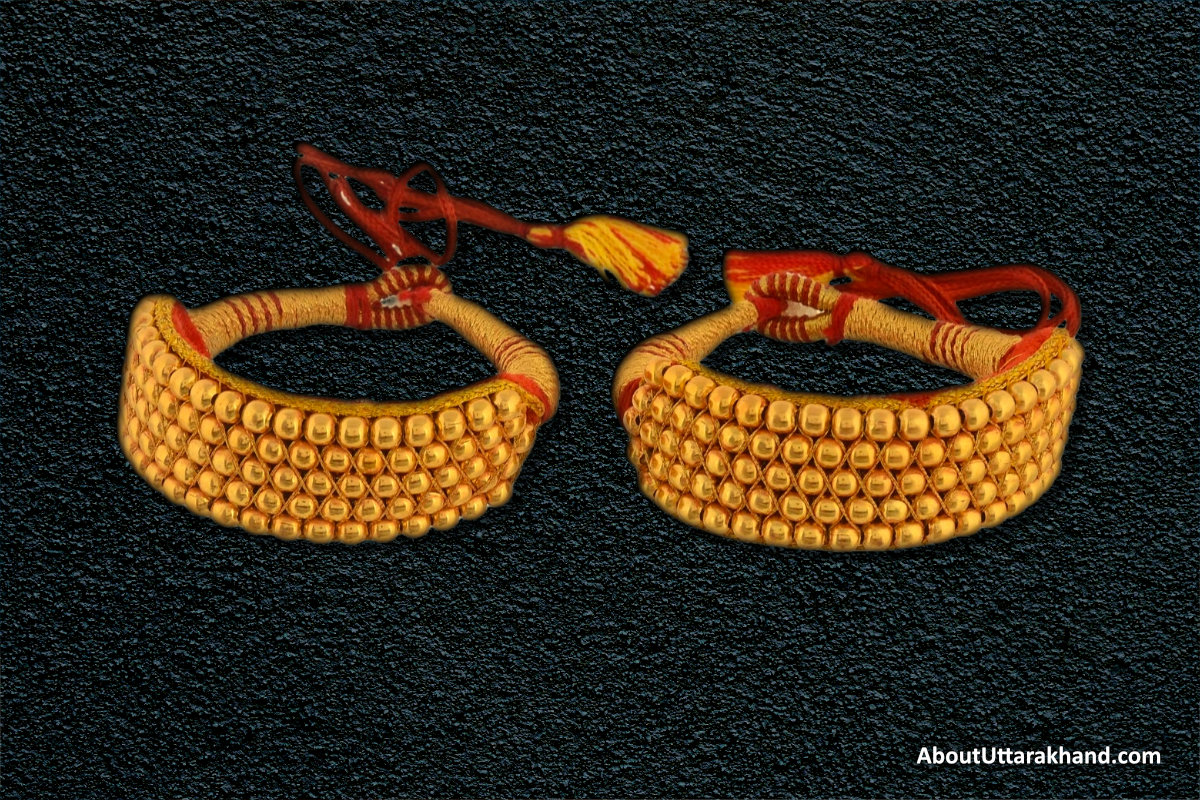
Pahunchi, Traditional Ornament Of Uttarakhand | Photo By AboutUttarakhand.com
The traditional gold bangles of Uttarakhand, known as pahunchi, are highly valued in the cultures of the Kumaon and Garhwal areas. The Kumaon people hold the gold Pahunchi in the highest esteem; it is a lucky charm worn only by married ladies. These bangles are an integral part of the regional culture, worn during festivals and other significant family events to indicate marital status.
A painstaking procedure is required to build Pahunchi. The quantity, which is usually 1 tola or more, is a reflection of the social position of the bride's family. The bangles are made with a red cloth foundation that is decorated with genuine gold pearls that are studded onto it with great attention to detail. Married ladies traditionally wear red as a sign of good fortune and cultural significance, in addition to its aesthetic value.
As a result, the Pahunchi serves as more than just an adornment; it is a symbol of cultural identity and lineage. The cultural subtleties and painstaking workmanship seen in traditional Pahunchi bangles are emphasised by their use of auspicious colours and careful craftsmanship.
Finally, Pahunchi is a representation of Uttarakhandi culture and heritage. Wearing these gold bangles on special occasions is a constant reminder of the region's rich cultural heritage and its long-standing traditions.
Pauje

Pauje, Traditional Ornament Of Uttarakhand | Photo By AboutUttarakhand.com
The traditional anklet of Uttarakhand, known as pauje, is different from the payal and pazeb that ladies in India typically wear. One thing that makes Pauje, which can be made of either silver or copper, stand out is its distinctive design. Pauje is distinctive due to the abundance of ghunghroos, or metallic bells, as opposed to the intricate web-like patterns typically seen in payals embellished with Indian designs. This one-of-a-kind element goes into making the anklet jingle in a melodic way, giving it a sound that is uniquely Pahari.
Because of cultural and geographical differences, Pauje designs in Kumaun, Garhwal, and Jaunsar may differ. Regardless of these variations, Pauje is still a popular piece of Pahari jewellery that represents the tradition of Uttarakhand.
Anklets made of silver or copper are more attractive and have more cultural value. To the Pahari people, the pauje is more than just an accessory; it is a sign of their culture and identity. The ghunghroos' jingling sound not only complements the wearer's motions but also calls attention to the artistic and cultural importance of the anklet.
Finally, the Pauje is a vibrant representation of Pahari culture; it is a symphony of metallic bells and the wearer's footsteps that echoes through Uttarakhand's storied past.
Sitarami
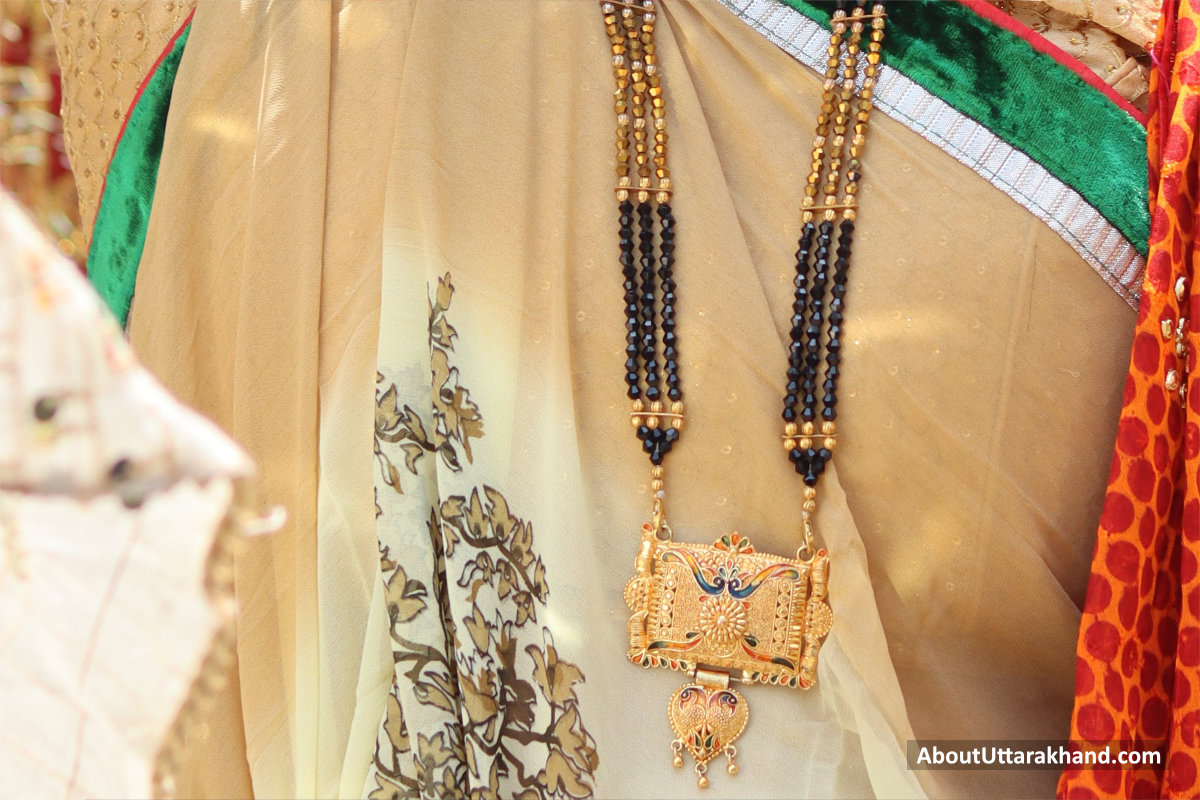
baby-boy-names-and-meaning | Photo By Contributor on pexels
An outstanding example of Uttarakhand's illustrious ornamental legacy is Sitarami jewellery, sometimes called Sita haar or Haram. The extravagant and one-of-a-kind necklace is distinguished by its many gold chains that are connected at regular intervals by gold plates that showcase elaborate patterns. Rani haars are easily recognisable by their unusual shape, lengthened strands, and heft—often 40 to 50 grams—that exceeds that of ordinary necklaces.
Cultural associations are inherent in the name 'Sitaram,' which is derived from the names of the famed Hindu gods Sita and Rama. This elevates the adornment beyond its mere jewellery status by imbuing it with spiritual meaning. Local artists have been passing their skills down through the years, and it shows in the elaborate design on the gold plates.
A lengthy gold chain with a heavy and elaborately carved pendant was the traditional component of a Sitaram necklace. Wearing a rani haar is a surefire way to turn heads at weddings, festivals, and other major cultural events thanks to its substantial weight and intricate design.
To conclude, Sitaram jewellery is a cultural artefact that links its owners to their spiritual and ancestral roots while also embodying the majesty of traditional Pahari decoration. The Sitaram necklace is cherished by the people of Uttarakhand for its beautiful craftsmanship, cultural significance, and significance as a symbol of beauty.
Occasion When Ornaments Of Uttarakhand Is Worn
The Uttarakhandi jewellery is known for its rich cultural heritage and the many functions it serves. The people of Uttarakhand don these traditional ornaments at festivals, religious rituals, and special occasions. The glitter of golden, silver, and copper decorations lights up the festive ambiance during celebrations like as Diwali, Dussehra, and Makar Sankranti, signifying good fortune and new beginnings.
Exquisite traditional jewellery is the main attraction during Uttarakhand weddings, which are lavish ceremonies. Every piece of jewellery that a bride wears, from nose rings and bangles to necklaces and earrings, is carefully chosen for its symbolic meaning. Not only can these accessories make the bride more stunning, but they also serve as symbols of the family's history and social status.
These priceless jewellery are worn during religious rituals, such as 'yajnas' and 'pujas', to show respect and devotion. Delicate to ornate, the choice of decoration is a reflection of the event's significance. Uttarakhandi jewellery, whether worn during festive festivities or serious ceremonies, is a beautiful representation of the region's rich cultural heritage and a link between the past and the present.
Availability Of Ornaments Of Uttarakhand
You may find a broad variety of traditional Uttarakhandi ornaments, which showcase the region's vibrant cultural heritage, at craft shops, jewellery stores, and local markets all around the state. Made with care and artistic flair, these trinkets are perfect for visitors and residents alike who want to experience the rich history of Uttarakhand.
A wide variety of traditional jewellery may be found in local marketplaces, especially in cities and towns such as Dehradun, Haridwar, and Nainital. The exquisite craftsmanship that characterises Uttarakhandi culture is on full display in the many jewellery made of metals such as gold, silver, and copper that feature granulation, regional themes, and elaborate filigree work.
Traditional jewellery from Uttarakhand has also become renowned outside of the state. The one-of-a-kind jewels from this Himalayan region are accessible to fans all over the world through a variety of online platforms and specialised boutiques that cater to a global clientele.
Whether in crowded local markets or on contemporary e-commerce platforms, Uttarakhand's traditional ornaments are readily available, guaranteeing their continued adoration and appreciation and creating a bond between the region's rich heritage and those who wish to accessories themselves with it.
To Conclude
To conclude, the traditional Uttarakhandi ornaments are glimmering representations of the artistic talent and cultural history of the state. The symbolic themes that mirror nature and mythology and the elaborate filigree work that embellishes these pieces tell tales of heritage and character. These decorations are more than just adornments; they are physical manifestations of devotion, cultural pride, and good fortune when worn during religious ceremonies, weddings, and festivals.
Beyond local markets, these valuable works may be found in specialised shops and on online platforms, appealing to connoisseurs all over the world. The traditional jewellery of Uttarakhand is loved by people all over the world, and this is because it is so easily accessible.
As these decorations are treasured and handed down through the years, they represent a link between the past and the present that will never fade. The traditional jewellery of Uttarakhand is more than just a pretty piece of jewellery; it is a representation of the artistry, symbolism, and cultural strength of this beautiful Himalayan state. The creativity and traditions of Uttarakhand shine through in every item, beckoning everyone to marvel at and rejoice in their everlasting beauty.

Belle Fable, keeps your trend ahead!
Gaumukh Glacier
The stunning Gaumukh Glacier, in the Uttarkashi region of Uttarakhand, India, is situated close to Gangotri and framed by the towering Garhwal Himalayas. Glaciers like this one attract tourists, hikers, and nature lovers from all over the globe because of the deep religious significance they have for Hindus as the headwaters of the holy Ganges River. The ascent to Gaumukh is an adventure in body and spirit, providing an opportunity to commune with the holy and the natural world.
Nandhaur Wildlife Sanctuary
The Nandhaur Wildlife Sanctuary is a haven for wildlife and stunning scenery, set in the tranquil hills of Uttarakhand. This sanctuary, in the Nainital District close to Haldwani, is a paradise for people who appreciate nature and animals. Its varied habitats, which include grasslands, ponds, and thick forests, have earned it recognition across its 269 square kilometers of territory.
Sonanadi Wildlife Sanctuary
The Sonanadi Wildlife Sanctuary invites animal lovers and nature lovers to come and enjoy the quiet beauty of Uttarakhand's serene surroundings. Hidden in the Nainital District, not far from Nainital, lies a refuge that begs to be discovered. Its varied wildlife and flora make this area, which covers around 301.18 square kilometers, a popular destination for ecotourists and those interested in biodiversity.
Binsar Wildlife Sanctuary
The Binsar Wildlife Sanctuary is a haven for wildlife and a monument to Uttarakhand's rich biodiversity, is situated in the picturesque Kumaon Himalayas. Nature lovers and wildlife aficionados will find this refuge, situated near Almora in the Almora District, to be a paradise. Covering about 47.04 square kilometers, it is famous for its verdant forests, varied fauna, and breathtaking views of the Himalayan mountains in the distance.
Tawaghat Wildlife Sanctuary
The Tawaghat Wildlife Sanctuary is a haven for adventurers and ecotourists, tucked away in the foothills of the towering Himalayas. This hidden gem of a sanctuary is located near Dharchula in Uttarakhand's Pithoragarh District. Despite its relatively tiny size (around 70 square km), this animal sanctuary is just as magical as any other.
Chilla Wildlife Sanctuary
.The Chilla Wildlife Sanctuary, located on the banks of the pure Ganges River, is a living monument to the beauty and variety of Uttarakhand's natural landscape. This sanctuary is a paradise for anyone who love nature and wildlife; it is located in the Pauri Garhwal District, close to Rishikesh. Covering over 249 square kilometers, it is a major wildlife sanctuary in the state that provides a peaceful haven amidst the majestic Himalayas.






